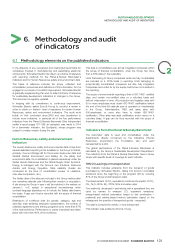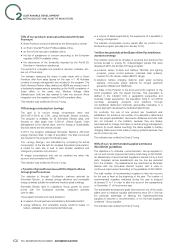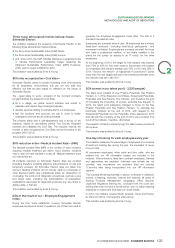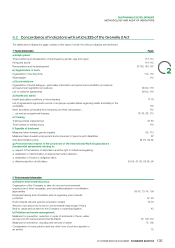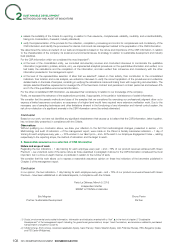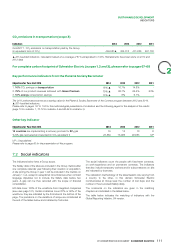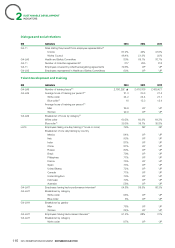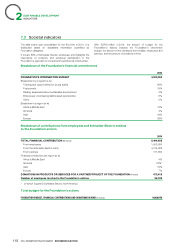APC 2014 Annual Report Download - page 110
Download and view the complete annual report
Please find page 110 of the 2014 APC annual report below. You can navigate through the pages in the report by either clicking on the pages listed below, or by using the keyword search tool below to find specific information within the annual report.
2SUSTAINABLE DEVELOPMENT
METHODOLOGY AND AUDIT OF INDICATORS
assess the suitability of the Criteria for reporting, in relation to their relevance, completeness, reliability, neutrality, and understandability,
l
taking into consideration, if relevant, industry standards;
verify the implementation of the process for the collection, compilation, processing and control for completeness and consistency of the
l
CSR Information and identify the procedures for internal control and risk management related to the preparation of the CSR Information.
We determined the nature and extent of our tests and inspections based on the nature and importance of the CSR Information, in relation
to the characteristics of the company, its social and environmental issues, its strategy in relation to sustainable development and industry
best practices.
For the CSR Information which we considered the most important(1):
at the level of the consolidated entity, we consulted documentary sources and conducted interviews to corroborate the qualitative
l
information (organization, policies, actions, etc.), we implemented analytical procedures on the quantitative information and verified, on a
test basis, the calculations and the compilation of the information, and also verified their coherence and consistency with the other
information presented in the management report;
at the level of the representative selection of sites that we selected(2), based on their activity, their contribution to the consolidated
l
indicators, their location and a risk analysis, we undertook interviews to verify the correct application of the procedures and undertook
detailed tests on the basis of samples, consisting in verifying the calculations made and linking them with supporting documentation. The
sample selected therefore represented on average 5% of the fixed-term contract and permanent contract personnel and between 8%
and 14% of the quantitative environmental information.
For the other consolidated CSR information, we assessed their consistency in relation to our knowledge of the company.
Finally, we assessed the relevance of the explanations provided, if appropriate, in the partial or total absence of certain information.
We consider that the sample methods and sizes of the samples that we considered by exercising our professional judgment allow us to
express a limited assurance conclusion; an assurance of a higher level would have required more extensive verification work. Due to the
necessary use of sampling techniques and other limitations inherent in the functioning of any information and internal control system, the
risk of non-detection of a significant anomaly in the CSR Information cannot be entirely eliminated.
Conclusion
Based on our work, we have not identified any significant misstatement that causes us to believe that the CSR Information, taken together,
has not been fairly presented, in compliance with the Criteria.
Observations
Without qualifying our conclusion above, we draw your attention to the fact that methodological changes, presented in section « 2.6
Methodology and audit of indicators » of the management report, were made on the Planet & Society barometer indicators « 1 day of
training for each employee every year », « 30% women in our talent pool », and « 63% result in our Employee Engagement Index », relating
respectively to the reporting scope, the method of calculation and the target to reach.
3. Reasonable assurance on a selection of CSR Information
Nature and scope of work
Regarding the two indicators « 1 day training for each employee every year » and « 75% of our product revenues achieved with Green
Premium », we undertook work of the same nature as those described in paragraph 2 above for the CSR Information considered the most
important, but in a more in-depth manner, in particular in relation to the number of tests.
We consider that this work allows us to express a reasonable assurance opinion on these two indicators of the barometer published in
Chapter 2 of the management report.
Conclusion
In our opinion, the two indicators « 1 day training for each employee every year » and « 75% of our product revenues achieved with Green
Premium » have been established, in all material aspects, in compliance with the Criteria.
Paris-La Défense, March9, 2015
Independent Verifier
ERNST & YOUNG et Associés
Eric Mugnier Bruno Perrin
Partner, Sustainable Development Partner
Social, environmental and societal information: information and indicators marked with a “tick” ▲ in the text of chapter 2 “Sustainable
(1)
Development” of the management report including, for greenhouse gas emissions, scope 1 and 2 emissions, and emissions related to purchased
transportation (included in scope 3).
SSAM (China), SSIC (China), Universal Capellades (Spain), Sarel (France), Telvent Madrid (Spain), ZAO Potential (Russia), ITBU Bangalore (India), (2)
and ITB Cavite (Philippines).
108 2014 REGISTRATION DOCUMENT SCHNEIDER ELECTRIC





